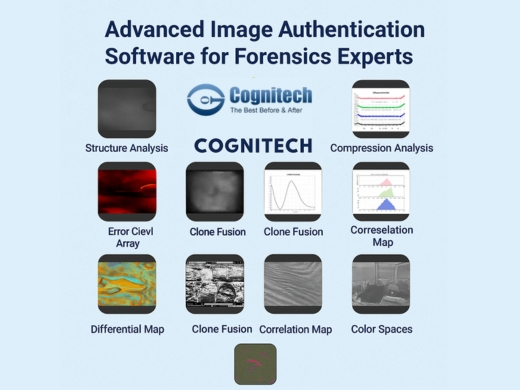Advanced Image Authentication Software for Forensics Experts
In today’s world, images aren’t always what they seem. From social media filters to sophisticated editing tools, altering a digital photo has become easier than ever. But in the world of law enforcement, defense, and forensics, a single photo can make or break a case. That’s where image authentication software steps in. It’s not just about spotting Photoshop tricks, it’s about uncovering the truth with scientifically reliable methods that hold up in court.
At Cognitech, we’ve spent decades perfecting forensic software tools that allow investigators to dig beneath the surface of a digital image. Our FiA solution Forensic Image Authentication gives experts the ability to detect tampering, analyze file structures, and prepare detailed, court-ready reports. Let’s break down how this works and why it matters.

Why Image Authentication Matters
Imagine an image submitted as evidence in a criminal trial. On the surface, it looks ordinary but what if a crucial detail was digitally removed or altered? Without the right tools, those manipulations might go unnoticed.
That’s why forensic experts rely on forensics software built specifically for authentication. It’s not about guessing or “eye-balling” edits. It’s about applying proven scientific methods that reveal whether an image is genuine, modified, or even recompressed. With these insights, investigators can stand in court with confidence, knowing the analysis is supported by data, not assumptions.
The Science Behind Authentication
So, how does image authentication software like FiA actually work? At its core, the process is about analyzing the digital “fingerprints” every image carries. Even the smallest alteration whether it’s cropping, cloning, or adjusting brightness leaves behind subtle inconsistencies.
Here are a few ways forensic experts can uncover those traces:
- Structure & Metadata Analysis: Every image file has a structure, along with hidden metadata (like the camera brand, model, or even editing software used). Comparing these details often exposes whether an image has been doctored.
- Compression & Recompression Tests: Many formats, like JPG, leave behind unique patterns during compression. By checking for double compression or irregularities across RGB channels, analysts can detect tampering.
- Color & Pixel Mapping: Authentic images show consistent pixel patterns and correlations. When something’s been copied, pasted, or manipulated, those patterns break down—and software can highlight exactly where.
- PRNU Camera Analysis: Every camera sensor has a unique “signature” called Photo Response Non-Uniformity. By comparing an image to reference shots, experts can confirm if it really came from a specific camera.
- Clone & Ghost Detection:When parts of an image are duplicated or erased, advanced maps like ghost analysis or clone fusion reveal those edits, even when they’re invisible to the naked eye.
Each of these techniques might sound highly technical, but together they form a clear, reliable picture of an image’s authenticity.
From Analysis to Court-Ready Reports
It’s not enough to simply point out that an image “looks suspicious.” Forensic software must deliver results that meet the strict standards of legal proceedings.
That’s where FiA stands out. Our system not only identifies tampering but also organizes the evidence, logs every analysis step, and generates detailed reports that investigators can present in court. Whether it’s one photo or a full folder of evidence, FiA’s batching tools streamline the workflow and ensure nothing gets overlooked.
Built for Experts, Backed by Research
Cognitech has been innovating in forensic video and image analysis since 1988, and FiA reflects that depth of research. Every feature from adaptive error level analysis to customized batch processing has been developed with real-world cases in mind.
And the work doesn’t stop here. Ongoing research continues to expand FiA’s capabilities, including extending its powerful authentication tools to video evidence. The goal is simple: to give forensic experts the most reliable, scientifically sound methods for uncovering the truth in digital evidence.
The Bottom Line
Digital images can lie but with the right tools, the truth always comes out. Image authentication software like Cognitech FiA empowers forensic professionals to detect tampering, confirm authenticity, and present findings that stand up to the toughest legal scrutiny.
For law enforcement agencies, defense teams, and forensic labs, having trustworthy forensics software isn’t optional, it’s essential. With FiA, you’re not just analyzing images, you’re safeguarding justice.
Talk with experts for Forensic video Processing Software and Forensic Image Processing Software solutions. Contact Cognitech! We hope you enjoyed this Blog! Stay tuned, and don’t miss the coming blogs. You can follow us on Twitter, Facebook, Instagram, Linkedln, or Youtube: we post Community Blogs regularly so you won’t miss any!
FAQs
- What is image authentication software?
Image authentication software is a forensic tool used to verify whether a digital image is original or has been tampered with. It analyzes file structures, metadata, and pixel patterns to detect editing or manipulation. - How does forensic software detect tampered images?
Forensic software uses scientific methods like error level analysis, compression checks, and metadata extraction to uncover traces of image editing, cloning, or recompression. - Can authenticated images be used in court?
Yes. Authentication results from specialized forensic software, like Cognitech FiA, are designed to meet legal standards and can be included in official court-ready reports. - Why is image authentication important for law enforcement?
Image authentication is crucial for law enforcement because manipulated photos can mislead investigations. Reliable forensic analysis ensures evidence is trustworthy and admissible in court.
